
The Boeing Vertol CH-46 Sea Knight is an American medium-lift tandem-rotor transport helicopter powered by twin turboshaft engines. It was designed by Vertol and manufactured by Boeing Vertol following Vertol's acquisition by Boeing.
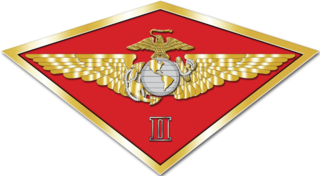
The 2nd Marine Aircraft Wing is the major east coast aviation unit of the United States Marine Corps and is headquartered in Marine Corps Air Station Cherry Point, North Carolina. The Wing provides the aviation combat element for the II Marine Expeditionary Force.
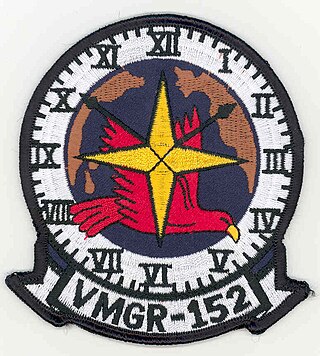
Marine Aerial Refueler Transport Squadron 152 (VMGR-152) provides aerial refueling service to support Fleet Marine Force (FMF) air operations; and provides assault air transport of personnel, equipment, and supplies. The squadron, known as the "Sumos", flies the fixed-wing Lockheed Martin KC-130J aircraft. VMGR-152 is stationed at Marine Corps Air Station Iwakuni, Iwakuni, Japan and is part of Marine Aircraft Group 12 (MAG-12) and the 1st Marine Aircraft Wing.

Marine Fighter Attack Squadron 115 (VMFA-115) was a United States Marine Corps F/A-18 Hornet squadron. Officially nicknamed the "Silver Eagles" and on occasion Joe's Jokers after their first commanding officer Major Joe Foss, the squadron was last based at Marine Corps Air Station Beaufort, South Carolina and fell under the command of Marine Aircraft Group 31 (MAG-31) and the 2nd Marine Aircraft Wing. The squadron participated in combat operations during World War II, the Korean and Vietnam Wars and has deployed in support of Operation Iraqi Freedom with a final deployment in 2008 to Al Asad Airbase in western Iraq. The Squadron radio callsign was "Blade".

Marine Aerial Refueler Transport Squadron 352 (VMGR-352) is a United States Marine Corps KC-130J squadron. They are a part of Marine Aircraft Group 11 (MAG-11), 3rd Marine Aircraft Wing and provide both fixed-wing and rotary-wing aerial refueling capabilities to support Fleet Marine Force (FMF) air operations in addition to assault air transport of personnel, equipment, and supplies. The squadron, known as the "Raiders" is stationed at Marine Corps Air Station Miramar, California.
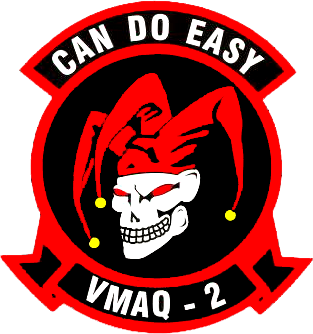
Marine Tactical Electronic Warfare Squadron 2 (VMAQ-2) was a United States Marine Corps electronic warfare squadron in service from 1952 to 2019. It was the last squadron flying the Northrop Grumman EA-6B Prowler.

Marine Medium Tiltrotor Squadron 263 (VMM-263) is a United States Marine Corps tiltrotor squadron consisting of MV-22B Osprey transport aircraft. The squadron, known as the "Thunder Chickens", is based at Marine Corps Air Station New River, North Carolina and falls under the command of Marine Aircraft Group 26 (MAG-26) and the 2nd Marine Aircraft Wing.
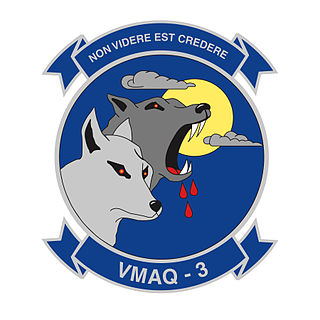
Marine Tactical Electronic Warfare Squadron 3 (VMAQ-3) was one of four Tactical Electronic Warfare Squadrons in the United States Marine Corps. The squadron consisted EA-6B Prowler jets and was tasked with conducting airborne electronic warfare. The squadron was based at Marine Corps Air Station Cherry Point, North Carolina and fell under the command of Marine Aircraft Group 14 (MAG-14) and the 2nd Marine Aircraft Wing. The squadron was decommissioned on May 11, 2018 as the Marine Corps sunsets the EA-6B Prowler.
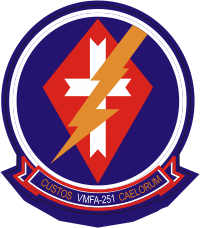
Marine Fighter Attack Squadron 251 (VMFA-251) was a United States Marine Corps F/A-18 Hornet squadron. Known as the "Thunderbolts", the squadron was deactivated on 23 April 2020. If current plans hold, the squadron is to be re-activated by 2025 as a F-35C Lightning II and based at Marine Corps Air Station Cherry Point, North Carolina.

Marine Wing Support Squadron 273 (MWSS-273) is an aviation ground support unit of the United States Marine Corps. The squadron is based out of Marine Corps Air Station Beaufort, South Carolina and falls under the command of Marine Air Control Group 28 and the 2nd Marine Aircraft Wing. MWSS-273 has supported Marine Corps aviation operations around the world to include during the Gulf War and multiple combat tours in Iraq and Afghanistan.

Marine Wing Support Squadron 271 is an aviation ground support unit of the United States Marine Corps. They are based at Marine Corps Air Station Cherry Point, North Carolina. The squadron falls under the command of Marine Aircraft Group 14 and the 2nd Marine Aircraft Wing.

Marine Wing Support Squadron 274 (MWSS-274) is an aviation ground support unit of the United States Marine Corps. They are based out of Marine Corps Air Station Cherry Point, North Carolina. The squadron falls under the command of Marine Wing Support Group 27 and the 2nd Marine Aircraft Wing.

Marine Aerial Refueler Transport Squadron 252 (VMGR-252) is a United States Marine Corps KC-130J squadron. They are a part of Marine Aircraft Group 14 (MAG-14), 2nd Marine Aircraft Wing and provide both fixed-wing and rotary-wing aerial refueling capabilities to support Fleet Marine Force air operations in addition to assault air transport of personnel, equipment, and supplies. The squadron, known as "Otis" is stationed at Marine Corps Air Station Cherry Point, North Carolina. It also has the distinction of being the oldest continually active squadron in the Marine Corps.

Marine Aviation Logistics Squadron 13 (MALS-13) is an aviation logistics support unit of the United States Marine Corps. Known as the "Black Widows", it is currently based at Marine Corps Air Station Yuma, as part of Marine Aircraft Group 13 and the 3rd Marine Aircraft Wing.
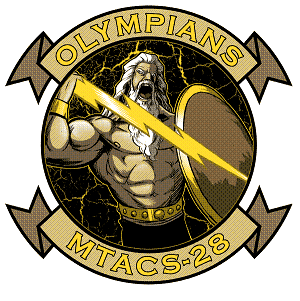
Marine Tactical Air Command Squadron 28 (MTACS-28) was a United States Marine Corps aviation command and control unit based at Marine Corps Air Station Cherry Point. They provided the 2nd Marine Aircraft Wings tactical headquarters and commanded other units within Marine Air Control Group 28. The unit was deactivated on 18 November 2022 as part of reshaping the United States Marine Corps.

Marine Aviation Logistics Squadron 26 (MALS-26) is an aviation logistics support unit of the United States Marine Corps. They are currently based at Marine Corps Air Station New River, North Carolina and fall under the command of Marine Aircraft Group 26 and the 2nd Marine Aircraft Wing.

Marine Heavy Helicopter Squadron 366 (HMH-366) was a United States Marine Corps helicopter squadron consisting of CH-53E Super Stallion heavy transport helicopters. The squadron, known as the "Hammerheads," was based at Marine Corps Air Station New River and fell under the command of Marine Aircraft Group 29 and the 2nd Marine Aircraft Wing. The squadron's tail code was “HH.” At the squadron's reactivation on September 30, 2008, it had 130 Marines and 8 aircraft on-hand which grew to more than 300 Marines and 16 aircraft in 2009. The squadron was decommissioned on December 16, 2022 in accordance with Force Design 2030
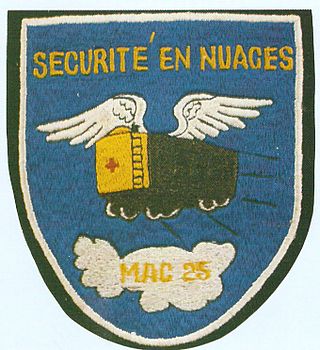
Marine Air Group (MAG) 25 was a United States Marine Corps combat air transport group that provided logistical support, including cargo and personnel transport and aeromedical evacuation, to forward units during World War II and the Korean War. During World War II it formed the nucleus of the South Pacific Combat Air Transport Command.
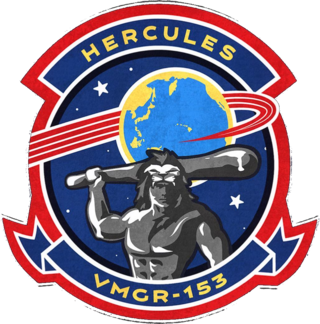
Marine Aerial Refueler Transport Squadron 153 (VMGR-153) is a United States Marine Corps KC-130J squadron. The squadron is a part of Marine Aircraft Group 24 (MAG-24), 1st Marine Aircraft Wing and provides both fixed-wing and rotary-wing aerial refueling capabilities to support Fleet Marine Force (FMF) air operations in addition to assault air transport of personnel, equipment, and supplies. During World War II, the squadron was under the command of Marine Aircraft Group 25 and the South Pacific Combat Air Transport Command (SCAT). It delivered approximately 15,000,000 pounds of supplies and equipment, evacuated more than 20,000 casualties, and moved an additional 8,000 personnel throughout the Pacific Theater. VMGR-153 is part of Marine Aircraft Group 24 (MAG-24) and is stationed at Marine Corps Air Station Kaneohe Bay, Hawaii.
Air Warning Squadron 14 (AWS-14) was a United States Marine Corps aviation command and control squadron during World War II. The squadron's primary mission was to provide aerial surveillance and early warning of approaching enemy aircraft during amphibious assaults. Formed in June 1944, the squadron was one of a handful of air warning squadrons that was never able to deploy overseas during the war. The squadron was decommissioned shortly after the end of the war in November 1945. To date, no other Marine Corps squadron has carried the lineage and honors of AWS-14 to include the former reserve Marine Air Control Squadron 14 (MACS-14).




















